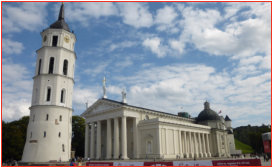





The Baltics*

/Vilnius
>Pilies Street
Pilies Street is the oldest and most flamboyant street in the Old Town of Vilnius. The street appeared in place of the former road from Vilnius Castle to the south, towards Poland and Russia. This was the main road to the castle. The name of Pilies Street was mentioned in historical annals as early as 1530. Kings, legates of the Pope, and envoys from other countries passed this street on their way to the castle and noblemen built their houses in Pilies Street. Vilnius University occupied a whole quarter of the city beside Pilies Street, and university professors used to live there. The broadest parts of the street were occupied
by markets: the so-called Great Market near the
Town Hall and the fish market next to St.
Paraskeva’s Church (Pyatnickaya). The street is
distinguished for its architectural variety: Pilies
12 and 14 are Gothic, Pilies 4 is a Renaissance
building of an episcopate college; and the
pediment of the Church St. John is Baroque.
The broadest parts of the street were occupied
by markets: the so-called Great Market near the
Town Hall and the fish market next to St.
Paraskeva’s Church (Pyatnickaya). The street is
distinguished for its architectural variety: Pilies
12 and 14 are Gothic, Pilies 4 is a Renaissance
building of an episcopate college; and the
pediment of the Church St. John is Baroque.
>Gediminas’ Tower of the
Upper Castle
 The Vilnius Castle Museum was opened in 1960,
and in 1968 it became a subdivision of the
Lithuanian National Museum. It displays
reconstruction models of Vilnius’ castles of the
second part of the 14th and the beginning of
the 17th centuries, armament, iconographic
material of old Vilnius. An observation deck on
the top of the Gediminas’ tower is excellent to
appreciate a magnificent panorama of Vilnius.
Visitors can walk up to the tower along a gentle
slope or take the 35 second funicular railway
that takes 16 people. It starts its journey up
from the only closed yard of the National
Museum, which you can access from the River
Neris side.
The Vilnius Castle Museum was opened in 1960,
and in 1968 it became a subdivision of the
Lithuanian National Museum. It displays
reconstruction models of Vilnius’ castles of the
second part of the 14th and the beginning of
the 17th centuries, armament, iconographic
material of old Vilnius. An observation deck on
the top of the Gediminas’ tower is excellent to
appreciate a magnificent panorama of Vilnius.
Visitors can walk up to the tower along a gentle
slope or take the 35 second funicular railway
that takes 16 people. It starts its journey up
from the only closed yard of the National
Museum, which you can access from the River
Neris side.
>Grand Cathedral of Peter
and Paul
St Peter and Paul’s Church is a masterpiece of the 17th-century Baroque famous for its exceptional interior where one can see about 2,000 stucco figures. Legend has it that there was a temple of the pagan goddess Milda on this site. Once there was a wooden church there, which was destroyed during the time of wars with Moscow. The present Church was built by Hetman Mykolas Kazimieras Pacas who wanted to perpetuate Vilnius liberation from Russians. The Church acquired its present appearance in 1676, later it was adorned with stucco, frescoes. At the beginning of the 19th century its Rococo pulpit was made.>Palace of the Grand Dukes
 The reconstructed Palace of the Grand Dukes of
Lithuania, the former political, diplomatic,
cultural center of the State, was one of the most
famous in Europe in the 15th-17th centuries
and was demolished in the beginning of the
19th century. The Palace is located in the heart
of Vilnius, within the confines of the Lower
Castle. Nowadays, the Gothic, Renaissance and
Early Baroque halls of this multifunctional
Museum are used for many different public
events and official visits.
Part of the reconstructed Palace of the Grand
Dukes in Vilnius Lower Castle officially
transferred to be a Museum. There are two
exhibition tour routes directly related to the
historical functions of this residence. The first
tour shows the historical and architectural
development of the
palace by
highlighting the
ancient ruins still in
place, excavated
artifacts and by
using models and
iconographic
materials. The
second tour route
shows the ceremonial halls, which have been
reconstructed in such a way as to show the
evolution of architectural styles – from the late
Gothic to the Renaissance to the early Baroque.
The reconstructed Palace of the Grand Dukes of
Lithuania, the former political, diplomatic,
cultural center of the State, was one of the most
famous in Europe in the 15th-17th centuries
and was demolished in the beginning of the
19th century. The Palace is located in the heart
of Vilnius, within the confines of the Lower
Castle. Nowadays, the Gothic, Renaissance and
Early Baroque halls of this multifunctional
Museum are used for many different public
events and official visits.
Part of the reconstructed Palace of the Grand
Dukes in Vilnius Lower Castle officially
transferred to be a Museum. There are two
exhibition tour routes directly related to the
historical functions of this residence. The first
tour shows the historical and architectural
development of the
palace by
highlighting the
ancient ruins still in
place, excavated
artifacts and by
using models and
iconographic
materials. The
second tour route
shows the ceremonial halls, which have been
reconstructed in such a way as to show the
evolution of architectural styles – from the late
Gothic to the Renaissance to the early Baroque.
>The small Church of St. Anna
The church of St Anne is a masterpiece of the late Gothic period. Popular legend has it that Napoleon Bonaparte, who was fascinated by the beauty of the church, wanted to take it back to Paris in the palm of his hand. Unfortunately, the reality is not that romantic: during the march of the Napoleonic army through Lithuania, the church was consigned to the French cavalry forces. However, Napoleon did mention in a letter to his wife that “Vilnius is a very beautiful city“. St Anne’s Church, which has survived to the
present day without changing for over 500
years, has become a symbol of Vilnius. At a
closer look, one can see the letters A and M in
the main facade of St Anne‘s. The letters A and
M could stand for the Latin Ana Mater Maria or
Ave Maria, i.e. “Saint Anne – Mother of Mary“ or
“Hail Mary“. Some experts claim that the Pillars
of Gediminas have been highlighted in the
composition of the facade with the three towers
of the church corresponding to the three pillars.
Next to the church there is a bell tower in the
Gothic style and built in the 19th century.
St Anne’s Church, which has survived to the
present day without changing for over 500
years, has become a symbol of Vilnius. At a
closer look, one can see the letters A and M in
the main facade of St Anne‘s. The letters A and
M could stand for the Latin Ana Mater Maria or
Ave Maria, i.e. “Saint Anne – Mother of Mary“ or
“Hail Mary“. Some experts claim that the Pillars
of Gediminas have been highlighted in the
composition of the facade with the three towers
of the church corresponding to the three pillars.
Next to the church there is a bell tower in the
Gothic style and built in the 19th century.
>The Cathedral of St.
Stanislav and St. Vladislav
The Cathedral of St. Stanislav and St. Vladislav is the most important place of worship for the country‘s Catholics and the venue for the main Christian, folk and national festivities. In 1922, the Cathedral was granted the title basilica (meaning ‘royal’). This is the highest church category awarded by the Pope only to very special churches. Many prominent people of the Lithuanian
Grand Duchy – noblemen, bishops and dukes –
are buried in the vaults of the Cathedral. The
Sovereigns Mausoleum located beneath the
Chapel of St. Casimir contains the remains of
the Grand Duke of Lithuania and King of Poland
Alexander. He is the only ruler of Polan and
Lithuania buried in Vilnius. Vytautas the Great, a
grandson of Duke Gediminas and the most
powerful Lithuanian ruler, is buried in the vaults
of the Cathedral together with his wife Ona.
Two wives of Žygimantas Augustas, Queen
Elisabeth of Austria (Habsburg) and Queen
Barbora Radvilaitė (said to have been the most
beautiful woman of her time), are also buried
here.
Many prominent people of the Lithuanian
Grand Duchy – noblemen, bishops and dukes –
are buried in the vaults of the Cathedral. The
Sovereigns Mausoleum located beneath the
Chapel of St. Casimir contains the remains of
the Grand Duke of Lithuania and King of Poland
Alexander. He is the only ruler of Polan and
Lithuania buried in Vilnius. Vytautas the Great, a
grandson of Duke Gediminas and the most
powerful Lithuanian ruler, is buried in the vaults
of the Cathedral together with his wife Ona.
Two wives of Žygimantas Augustas, Queen
Elisabeth of Austria (Habsburg) and Queen
Barbora Radvilaitė (said to have been the most
beautiful woman of her time), are also buried
here.
 The walls of the Cathedral also provide shelter
for the urn with the heart of King Vladislovas
Vaza (Wladyslaw Vasa). The ancient wall of the
temple dating back to the 13th-15th centuries,
and the oldest Lithuanian fresco painted in the
14th century, have survived in the vaults of the
Cathedral.
The walls of the Cathedral also provide shelter
for the urn with the heart of King Vladislovas
Vaza (Wladyslaw Vasa). The ancient wall of the
temple dating back to the 13th-15th centuries,
and the oldest Lithuanian fresco painted in the
14th century, have survived in the vaults of the
Cathedral.
>The University of Vilnius
 Vilnius University is one of the oldest
universities in Eastern Europe. It was founded at
a time when the reformation movement was
active in Lithuania and Jesuit monks were
invited to help fight the mood of reformation.
Jesuit monks were quick to take over education.
In 1569, they established a college and in 1579
the University of Vilnius was born.
The complexes of Vilnius University were
formed over several centuries and, as a result,
consist of the buildings built in Gothic, Baroque
and Classical styles. The medieval architecture
of the premises contrasts with the vibrant
student atmosphere. Thirteen internal
courtyards, arcades and galleries inject even
more colour into the buildings. The courtyards
are named after famous graduates and
professors of the university; commemorative
plaques in their honour can be seen in the
Grand Courtyard. The Botanical Garden of
Vilnius University was established in one of the
courtyards at the end of the 18th century.
Vilnius University is one of the oldest
universities in Eastern Europe. It was founded at
a time when the reformation movement was
active in Lithuania and Jesuit monks were
invited to help fight the mood of reformation.
Jesuit monks were quick to take over education.
In 1569, they established a college and in 1579
the University of Vilnius was born.
The complexes of Vilnius University were
formed over several centuries and, as a result,
consist of the buildings built in Gothic, Baroque
and Classical styles. The medieval architecture
of the premises contrasts with the vibrant
student atmosphere. Thirteen internal
courtyards, arcades and galleries inject even
more colour into the buildings. The courtyards
are named after famous graduates and
professors of the university; commemorative
plaques in their honour can be seen in the
Grand Courtyard. The Botanical Garden of
Vilnius University was established in one of the
courtyards at the end of the 18th century.
























